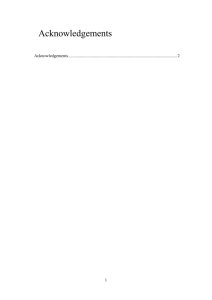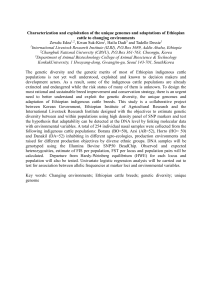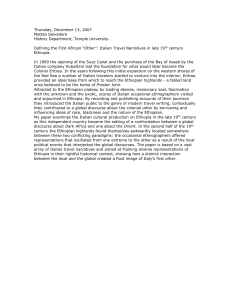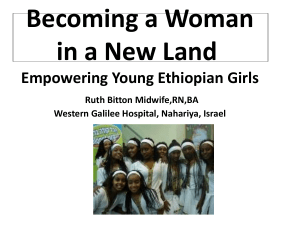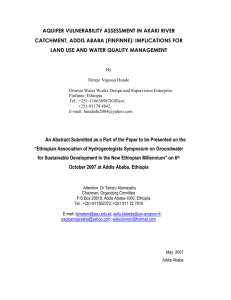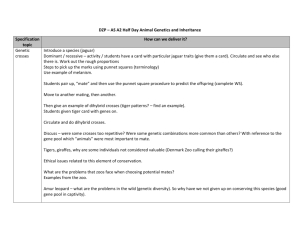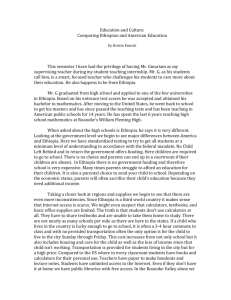The symbolic language of Ethiopian crosses: visualizing
advertisement
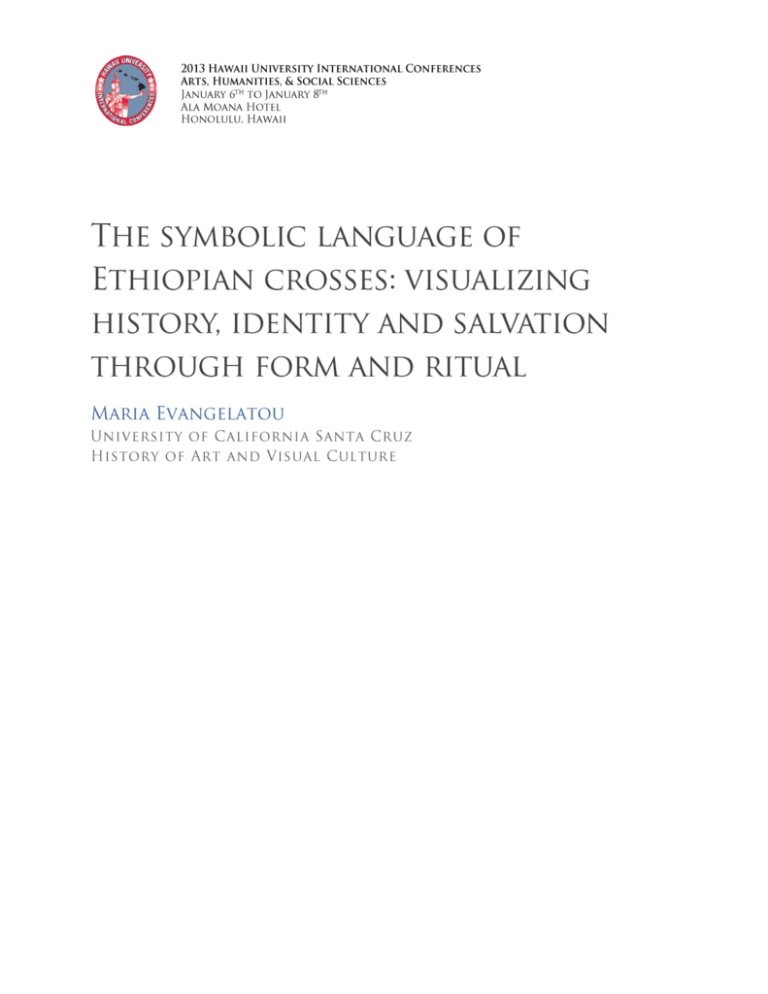
The symbolic language of Ethiopian crosses: visualizing history, identity and salvation through form and ritual Maria Evangelatou, Department of History of Art and Visual Culture, UCSC As the most important symbol of the Christian religion, the cross has been the subject of countless depictions through the centuries, in all the different cultures that adopted Christianity. Such representations are found in all kinds of contexts and media and are often characterized by great complexity and sophistication, incorporating visual elements that elaborate on the theological and devotional significance of this sign in connection to local cultural traditions. Ethiopia stands out among other Christian lands for the incomparable prominence of the cross in the life of its people and for the inexhaustible variety and intricacy of the patterns used to decorate cross-shaped objects of all kinds. In both the textual and visual culture of the Ethiopian Christians the cross has been venerated for centuries as the most important source of physical and spiritual protection and as a fundamental marker of communal and individual identity. Crosses of various forms and sizes are extensively used both in religious and magic rituals, as well as in the daily social interactions and personal experiences of people in a variety of contexts. In some regions of Ethiopia crosses crown not only churches but also private houses, and they might appear embroidered not just on traditional clothing but even on the skin of people (tattooed, branded or incised on their forehead, hands, or other parts of the body). In addition certain crosses are venerated as objects of miraculous provenance and properties, a status that in other Christian traditions is usually reserved to icons alone. The paramount importance of the cross is also reflected in Ethiopian traditions about critical moments of world history, from the first battle of the angels against Satan when th sign of the cross appeared as the luminous weapon of the angelic army, to the time of the Last Judgment, when a huge cross-tree will be the wondrous landmark around which the saved will gather. In Ethiopian tradition the cross is the sacred matrix that encompasses the life of the world in both its macrocosmic and microcosmic dimensions; and it is the social and cultural nexus through which and with which people interact in order to shape and express personal and communal identities and hopes. In this paper I will discuss some aspects of the visual complexity of Ethiopian crosses that have been developed over the centuries as a sophisticated system of symbolic references to the multilayered functions of this powerful sign. The intricate Ethiopian crosses that are used in religious contexts have been discussed in scholarly literature from various perspectives, such as their formal or conceptual relationship to pre-Christian or early Christian culture, their connection to Byzantine models, their cosmic symbolism, or their similarities to the structure of liturgical music, to mention just a few characteristic examples. My aim is to make some new observations that could shed more light on the multilayered symbolism of these objects and their subtle visual references to basic theological beliefs and devotional needs of Ethiopian Christians. In my analysis I combine textual and visual evidence, as well as aspects of Ethiopian history and cultural tradition. I conclude that Ethiopian crosses visualize a complex set of ideas that range from basic beliefs about universal history, to important concepts of socio-cultural and individual identity, combined with fervent hopes for protection and salvation. Thus they create a vibrant symbolic textile that interweaves communal and personal values and concerns with fundamental references to the material and spiritual dimensions of human existence. These references are most intensely activated in the context of religious rituals that guide the participants to internalize and embody through experience and interaction the abstract ideas visualized in the symbolic language of the crosses prominently used in those occasions. Ethiopian crosses on various media survive from an early period but become increasingly complex from the 15th century onwards. The weaving metaphor is an appropriate description of their formal and conceptual character: whether they are made of wood, metal, stone or leather, these crosses are based on patterns of interlocking threads and knots that create an intricate matrix on which other motifs and figures might be added. The visual effect is based on the repetition of self-similar patterns in different sizes, and on the balanced manipulation of matter and void that creates the impression of lace- or textile-like motifs. The creativity of Ethiopian craftsmen thrives in transforming the archetypical idea of a weave-like matrix into infinite imaginative variations. The fundamental symbolism of the basic design is amplified by the integration of different variables, enriching the overall message with meaningful details. In other words, although the details of each cross vary and new motifs are introduced over time, the basic characteristics of the weave-like matrix are observed throughout, suggesting the operation of a stable yet gradually enriched system of symbolic forms and underlying meanings. Before discussing some characteristic variables, I will focus on the basic aspects of the matrix. All the images of individual crosses used in this paper are of contemporary objects that reproduce traditional designs attested in older surviving examples, dating centuries back. Although in recent years many copies started being produced for the tourist market, in the past the majority of these crosses were used in an ecclesiastical context, and therefore scholars consider them the creation of monks, clerics or lay people trained within the educational framework of the Ethiopian Church. The most important patrons were members of the Ecclesiastical and State hierarchy, and the works they commissioned were closely supervised by high-ranking clergymen. Those figures of authority were invested in creating eloquent visualizations of interrelated socio-cultural and religious concepts that would be equally intelligible to the welleducated elite and the broader population. Indeed the diffusion of the basic patterns of Ethiopian crosses across social, spatial and temporal boundaries within the multicultural territory of this large Christian realm suggests their visual language was widely successful and meaningful -and continues to be so today. The applicability of basic cultural values in the interpretation of these crosses further reinforces the idea that their visual language is rich in symbolic meaning. I will be discussing portable crosses of three basic types that are used in various church rituals, daily interpersonal exchanges and individual life activities in the Christian culture of Ethiopia. A number of terms are used in the literature to describe these crosses, often leading to inconsistent definitions. I will be using three generic descriptive terms that refer to the way these objects are handled and presented: staff-mounted crosses, hand crosses and pendant crosses. Fig. 1. staff-mounted cross Staff-mounted crosses are very diffused in Ethiopia and are often characterized by great dimensions and very intricate decoration. They have a lower hollow shaft for insertion on a pole and they are usually cast, often in more parts that are then attached together. Although they are frequently called "processional", in reality they serve a variety of religious uses. A large staff-mounted cross is displayed to the congregation during the liturgy. Since the texts are read in Geez, a language understood by very few people today, the cross becomes a focal point on which the faithful can concentrate their gaze and prayers during the rite. When this cross is raised at the end of the liturgy, it gives the sign that the congregation can disperse. Such crosses are also displayed or taken to procession on various special occasions, like Church feasts, official celebrations, local anniversaries or times of crisis, when divine help is invoked. A characteristic aspect of all these crosses that is peculiar to the Ethiopian tradition is the pair of hooks or loops at the base of the vertical arm, from where a long cloth is appended and hangs along both sides of the shaft. According to a traditional interpretation, it symbolizes the colobium or loincloth of Christ at the Crucifixion. This idea complements the frequent identification of the cross itself with the very body of Christ, attested in various Ethiopian texts. Smaller staff-mounted crosses can be used as the crowning of pastoral rods, in which case the lower loops might be missing or be filled with decorative motifs, since they are not used to hold a textile. Through such rods religious leaders identify themselves as followers and imitators of Christ, guarding their flock as Good Shepherds who carry the cross. Pilgrims are also supposed to hold staff-mounted crosses as signs of their identity and mission: they are pious Christians devoted to an arduous trip that is a test and a proof of faith and at times requires intense perseverance and self-sacrifice. Such crosses can be much simpler than the more ceremonial ones used in church rituals, but they are equally important to their users, not simply as identity markers but also as protective objects that can guard the pilgrims from the various perils of their journey. Ethiopian hand-crosses and pendants are equally characteristic examples of the double function of this Christian sign as a source of protection and blessing and a marker of identity. Pendants, usually made in metal, wood or leather, are worn by people of both sexes and all ages, under or over clothing, close to the neck or on the chest, and are considered prominent signs of faith and sources of protection, often given to the wearers at the time of their baptism. Hand-crosses in metal or wood usually belong to clerics and monks and are therefore traditionally handled by men. Priests always carry with them a small hand-cross, normally between 4 and 10 inches in length, that is often a family heirloom inherited from father to son. They use it to bless the faithful who kiss the top and base of the cross every time they greet their pastor. Priests also display their handcross in front of their chest as a sign of their professional identity when they present themselves in ceremonial occasions or when they are photographed. Larger hand-crosses, usually between 12 to 24 inches long, are employed during the liturgy. One is held by the officiating priest and another, normally longer, rests on the left shoulder of the incensing deacon. Dabtaras, unordained clerics of the Ethiopian Church who also work as healers at the margins between religion and magic, hold large-hand crosses during the ritual dance they perform on feast days. Since monks are considered examples of holiness and are often called upon to bless people, they might also use a hand cross for their interaction with the faithful. Whether owned by clerics, dabtaras, or monks, hand-crosses are not only markers of identity and instruments in social exchange, articulating the relationship of their owners with the faithful they bless; they are also powerful protective objects that reinforce their holders in their daily struggle against temptations and light their path to spiritual life, moral conduct and Christian leadership. Fig. 2. Hand-cross As already mentioned, the most prominent visual feature of Ethiopian crosses is their lace-like character that is created by motifs that resemble knotted and interwoven threads. The practical advantage of this form in the case of metal crosses is that the voids included in the formation of the lace patterns (either through casting or cutting out of metal leafs) allows for less material to be used, which results in more economic and lighter objects. However, similar lace-like motifs are prominent in sculpted wooden crosses which are very light and cheap to begin with. In this case, it is obvious through the amount of work invested in the creation of the knotted and interwoven thread-like patterns that such motifs have important symbolic value; and this is why they are a constant feature of Ethiopian crosses, even in painted versions or stone-sculpted ones. The motif of knotted and interwoven threads that forms the matrix of most Ethiopian crosses has ancient roots in the culture of the Late Antique Mediterranean, where it was used widely as decoration in many different contexts, from mosaics and sculptures to jewelry and manuscript illumination. Based on the content of inscriptions that accompany such designs on floor mosaics and on the incantations that appear next to similar motifs in magic spell manuscripts, scholars have concluded that in Late Antiquity such knotted patterns were thought to have protective qualities. Indeed they are still abundantly used in the context of Ethiopian magic spells today, especially on healing scrolls. The employment of such motifs on the protective Christian sign par excellence mutually reinforces the effectiveness of both the cross and the knotted patterns as apotropaic and healing symbols. However, the interweaving of the threads that make up the basic matrix of Ethiopian crosses has many more symbolic meanings, all interrelated to the concepts of the protection and healing of humankind through the divine plan of salvation centered on Christ's Incarnation and Sacrifice. Interweaving is an ancient powerful symbol of unity, as are the textiles that are produced by it. In addition, textiles are potent symbols of protection, honor and revelation. In Christianity Christ's own body is described as the veil that clothes his divinity and makes it visible to the world . Indeed, the most important events of human history, from the Creation and the Fall, to the Incarnation and the Passion of Christ and finally the Baptism and Salvation of Christians, are described in terms of putting on or off symbolic clothing. The textile-like body of Ethiopian crosses seems to encompass all these pivotal moments in history on the sacred matrix of the instrument of Christ's Passion and triumph over death. In fact, the cloth appended from the large staff-mounted crosses used in the liturgy and in processions might relate specifically to one of the major turning points of human history that is described through a powerful textile metaphor in the Bible: according to the synoptic Gospels (Matthew 27:50-51, Mark 15;37-38, Luke 23:45-46), the veil of the Jewish Temple concealing the Holy of Holies in which only the High Priest could enter once a year was torn in two at the moment of Christ's death on the Cross. Christian exegetes interpreted this as a reference to the idea that through the sacrifice of Christ's body salvation was offered to the whole world. Through the parting of his bodily veil, all could have access to his salvific divinity: the true Holy of Holies, heaven itself, was now open to all Christians through the miracle of the Incarnation. The textile appended on Ethiopian crosses hangs down in two parts, left and right of the staff, like a veil that has been divided in two, opening up to reveal the divine mysteries of Incarnation, Passion and Salvation that are visualized through the sign of the cross, the instrument of Christ's martyrdom that tore his bodily veil in order to reopen the gates of paradise. So this actual textile could be an explicit reference to the soteriological meaning of the Crucifixion described in the Gospels through the symbol of the veil. In addition, the textile-like body of Ethiopian crosses could refer not only to this episode, but to the entire Christian tradition of textile metaphors and the multivalent symbolic allusions that are emphasized through the prominent motifs of interwoven threads forming the body of these objects. Fig. 3. Ethiopian priest with staff-mounted crosses. http://katewithdreadlocks.blogspot.com/2010/05/ethiopia.html Unity is not the only concept that is emphatically visualized through these motifs. Order is another significant reference, highlighted through the marked symmetry of the design. These two elements could refer to the relationship between God and humanity, which through Christ's sacrifice is reinstituted to its original harmony before the Fall. Unity and order can also refer to the relationship of the three person of the Trinity, all equal and inextricably connected. Indeed the unity of the Trinity has a very prominent place in Ethiopian religiosity, as is evident, for example, by the popularity of the depiction of the Trinity as three identical figures -an iconography that is rather rare in Eastern Orthodox cultures outside Ethiopia. In addition, the dogma of the Incarnation of the Logos through the unction of the Holy Spirit is very important to the Ethiopian Church. Most Ethiopian crosses seems to reflect the centrality of the Trinity in Ethiopian spirituality by their prominently tri-partite design and the triple repetition of their basic motifs. In addition, the same interlocking threads that weave the body of Ethiopian crosses have no visible beginning and end, as they all merge into an incessant flow. This element does not simply reinforce the idea of unity, but it also visualizes eternity: the everlasting nature and presence of God and his incessant actions for human salvation, that have in their center the Incarnation and Sacrifice of Christ. On a side note, the concepts of everlasting unity and order are important not only in a religious but also in a social sense: they validate and uphold the status quo that any monarchy wants to preserve, suggesting that the kingdom is peaceful and prosperous under the wise leadership of the divinely-appointed ruler. Until 1974 Ethiopia was ruled by a royal dynasty that claimed descent from the God-chosen kings of ancient Israel, David and Solomon, forefathers of Christ. The links between State and Church were very strong and the king was revered not only as a secular but also as a spiritual leader. In this context it is possible to perceive the cross as the Christian sign of the kingdom as a whole, its symbolism of unity and order referring not only to the relationship between God and humanity, but also to the harmony of the earthly realm as a reflection of the heavenly one, prospering under the leadership of the Ethiopian ruler who is divinely selected to represent the heavenly king on earth. Another significant aspect of the threaded matrix of Ethiopian crosses is the juxtaposition between material presence and absence (the solid thread-like components and the void spaces between them), in order to produce the perforated, lace-like design that creates a prominent interplay of shadow and light, materiality and immateriality. This significant combination could refer to two central concepts of Christian faith that are also prominent in Ethiopian religious texts: the union of humanity and divinity in Christ that makes possible the salvation of the world; and the union of matter and spirit in all human beings and their experiences, as well as in their hopes for both physical and spiritual salvation, the well-being of body and soul. Various motifs added on the basic matrix of Ethiopian crosses further enrich their symbolic significance and references to the history of the world and to human salvation. For examples, fruits and birds transform the cross into a tree, with connections to the Trees of Knowledge and Life that mark the beginning of human existence, offer wood for the True Cross and reappear at the end of time and humanity's return to paradise. In Ethiopian traditions the sign of the cross and the symbol of the tree have a very prominent place in narratives about the beginning and the end of time. In addition, stories about the Ethiopian queen of Sheba relate how she was the first to recognize the future significance of the miraculous wood from the Tree of Life that was destined to produce the True Cross, when she saw it in Solomon's city. In other words, in Ethiopian stories the interrelation between Tree and Cross also bears a special significance for the identity of the people who see their lineage going back to that Biblical queen and the son she bore from Solomon's seed. At times narrative episodes from the Bible or figures of saints appear on the main body or the shaft of Ethiopian crosses. This is a clear indication that the prevalence of abstract and non-anthropomorphic motifs on Ethiopian crosses is not the result of an aniconic tendency; nor does it signal an aversion to the depiction of Christ's Crucifixion, that some times appears on Ethiopian crosses but is not a frequent subject. From an early time Ethiopian visual culture thrived in the depiction of narrative and devotional images of Christ, Mary and the saints, and many depictions of the Crucifixion survive in this tradition. The basic reason for the preference of the abstract matrix on Ethiopian crosses is its symbolic power, that though combination with numerous variables (at times including narrative scenes or devotional figures) can communicate a wide array of messages about divine intervention and human salvation. A narrative depiction of the Crucifixion or a representation of the crucified body of Christ on such crosses would focus their reference on the specific historical event of the Passion. On the contrary, emphasis on the symbol of the cross obviously refers to the even of the Crucifixion, but it also allows for the inclusion of a much broader set of references that can encompass the outlines of the whole of human history from Creation to Last Judgment, and depending on the variable details added on the cross, can make more specific references to other important religious ideas, significant in Ethiopian spirituality or particularly interesting to the makers and commissioners of individual crosses. For example the depiction of a specific saint on the shaft or the main body of the cross highlights a holy figure of special interest to the makers and/or users of a cross, presents him as a faithful follower of Christ who picks up his cross to imitate the example of the Savior in self-sacrifice, and in the process he also becomes a living example of piety, steadfastness and moral struggle to the Ethiopians who are devoted to him. As an intercessor between the human and the divine spheres, the saint also becomes an intermediary between the users of the cross and the religious concepts that the sign represents. As his body is inscribed on the cross, so is the cross embodied in him, activating in a more concrete and personal form the ideas of continuous strive for union with God and hopes for protection and salvation. When the saint is a figure of particular significance for Ethiopian spirituality as a whole, the message is even more emphasized. Highly venerable monastic saints like Tekle Haymanot and Gabra Manfas Qeddus, who are particularly popular throughout the country and celebrated once every month throughout the year, are often represented on crosses. Their presence accentuates the values of self-sacrifice and service to others, unshaken devotion to God, unbent moral conduct and continuous struggle against the forces of evil. They express the Christian principles encompassed in the cross through their individual exemplary human lives that give a more personable and relatable aspect to the highest percepts of Christian faith. The protective character of the cross is coupled with the miraculous powers of the saints, whose depiction bestows an element of Ethiopian identity to the universal symbol of Christianity and enriches it with the immediacy and efficacy of personal devotion. The meaning and venerability of the Christian sign is not limited but on the contrary clarified and amplified by reference to saints who dedicated themselves to a life on the cross. This visual synchronicity of the instrument of Christ's Passion with the self-sacrifice of his later followers, seen on the body of Ethiopian crosses, is an exemplary manifestations of the transcendence of temporal boundaries in the context of religious experience: holy people, actions and values are of diachronic relevance, tracing the universal trajectory of salvation as an ongoing process of re-union between God and his people. Fig. 4. Staff-mounted cross with images of St. George and the Virgin and Child When the holy figure represented on an Ethiopian cross is St. George or the Virgin Mary, references to salvation, protection and union in the context of Ethiopian identity become even more accentuated: St. George is the patron saint of Ethiopia, so in a sense he embodies this nation which is in turn inscribed within the protective embrace of the Christian sign through the figure of the saint. If the cross is the sacred matrix of the universal history of salvation, then the image of St. George as victorious rider and vanquisher of evil depicted at the intersection of the cross arms situates Ethiopia in the center of divine providence. This idea of Ethiopians as the chosen people of God, central in his salvific plan, is even more accentuated when the Virgin and Child appear on the body of the cross: for Ethiopians Mary is not simply the instrument of the Incarnation through which human salvation is made possible, nor is she just the most powerful intercessor of humanity in front of her son's throne -functions for which she is highly venerated in Eastern Orthodox and Catholic traditions alike. In Ethiopia Mary and her son Christ are believed to be of the same blood-line as Ethiopians and especially their rulers, descendants of king Solomon. So when the Virgin and Child are inscribed on Ethiopian crosses, they do not simply visualize humanity's hope for salvation: they also speak of the special connection of Ethiopian Christians with their savior, as members of the same extended holy family, not simply in spiritual but also in physical terms. On Ethiopian crosses Christ and Mary are not simply the Savior and his Mother, the Groom and the Bride/Church leading Christians to God: they are the holiest members of the Ethiopian nation, protectors but also representatives of the Ethiopian people who are inscribed on the body of the cross through the very bodies of Mary and Christ. In this case the universal Christian symbol is invested with a specifically Ethiopian identity that goes beyond the formal elements of the visual tradition or a simple combination of the cross with the figure of local saints, in order to touch upon the core beliefs of this Christian nation about its sacred origins. The idea that Ethiopians share the same blood-line with Mary and Christ is based on the belief that Solomon (the forefather of Jesus) was the father of Menelik, the son of the Ethiopian queen of Sheba, who became king and progenitor of Ethiopia and its Solomonic dynasty of rulers. This belief of direct connection with the Davidic genealogy of the Messiah is unique among Christian nations and is further enriched with one more element of paramount significance for Ethiopian identity: the credence that according to divine providence Menelik brought with him in Ethiopia the Ark of the Covenant that is still believed to be in the possession of the Ethiopian Church today. This event is seen as a sign of divine favor that defines the Ethiopians as the new chosen people of God even before they become Christian. This important tradition can be related to a very unusual feature of Ethiopian hand-crosses: the developed base that appears at the other end of the main body of the cross and often bears similar intricate motifs, although on a smaller scale. Ethiopians are expected to kiss hand-crosses on that base part, but no adequate symbolic explanation has ever been offered for that very prominent component of the whole and its exclusive appearance on Ethiopian crosses. Considering its visual juxtaposition to the main body of the cross at the other end of the vertical shaft, I propose that this base, towards which Ethiopians pay special tribute, is a symbolic representation of the wooden Ark, an emblem of the Old Covenant of God with his chosen people and a prefiguration of the wooden True Cross, the instrument of the New Covenant crated through Christ's sacrifice. The Ark bore the Tablets of the Law and the True Cross bore the Living Law. Both manifested the presence and action of God for his people, and the one foreshadowed the other. In fact, the base part of Ethiopian hand-crosses often has a rectangular, chest-like appearance that might further reinforce the reference to the Ark of the Covenant. Fig. 5. Hand-crosses with a typical rectangular chest-like base. http://www.ebay.com/itm/2-X-ETHIOPIAN-COPTICHAND-CROSS-ORTHODOX-CHURCH-AFRICAN-ART-CHRISTIAN-ETHIOPIE-/261085290528 According to Old Testament descriptions of the Ark the container of the Tablets of the Law was overshadowed by two cherubim, winged guardians. In Christian tradition Mary, the container of Christ, is identified with the New Ark containing the Living Tablets of the Law. This idea is prominently expressed in Ethiopian visual culture with the depiction of the Virgin and Child flanked by two angels who lift one wing each to overshadow the Mother holding her Son. This iconographic detail clearly presents Mary as the New Ark. The theme often appears on Ethiopian crosses, visually reinforcing the connection between the Old and the New Testament, the Ark of the Covenant and the Ark of the Incarnation that are so important for Ethiopian identity. In addition, angels, who among other things could allude to the cherubim of the Ark, are frequently represented on Ethiopian crosses, perhaps further enhancing the connection between the wooden instrument of salvation and the wooden container of the Law. In fact, the connection between the Ark of the Law and Christ's sacrifice on the Cross (both marking pivotal moments in the relationship between God and his people) is referenced through a unique feature of Ethiopian Christianity that has a very prominent place in Church rituals: the tabot, a sacred object owned by every church, is an ark-chest containing an altar-tablet on which the Eucharist is celebrated. The tabot is treated by special reverence that resemble the handling of the Ark in the Old Testament (for example it is covered by a precious textile when it is presented in public, and it is carried in procession, accompanied by dancing and singing). The linguistic, formal and ritual identity of the tabot clearly refers to the idea of the Ark as the container of the New Living Law (the tablet on which the Eucharist, the body of Christ, is presented). This emphatic connection between the wooden Ark and the Passion of Jesus on the wooden Cross, could be also referenced in the unique form of Ethiopian hand-crosses with their prominent (and often chest-like) base. In fact, the rectangular proportions of the base on many hand-crosses are very similar to those of rectangular tabot chests which are often decorated with crosses. Fig. 6. Tabot. http://www.galenfrysinger.com/rock_church_ethiopia.htm It must be of particular importance that the visual reference to the Ark of the Covenant, so central to Ethiopian identity, appears on hand-crosses. Contrary to pendants which address more personal concerns of daily life and are handled only by the wearer, and contrary to staff-mounted crosses that are handled only by clerics and are viewed by the public from a distance, hand-crosses are central in the intimate social interaction of Church members with their flock. When they are presented by their owners and kissed by the faithful, they become instrumental in articulating relationships of power and activating religious and cultural beliefs that together define the identity of the people involved in this ceremonial interaction: in the process of enacting their respective roles, they reaffirm their belonging to specific groups and hierarchies; at the same time they acknowledge each other as members of the larger community of Ethiopian Christians, sharing a common pride in tracing their origins to the royal house of Israel, and celebrating their privileged relationship with God manifested through ownership of the Ark. At this point it is important to note that the symbolic language of Ethiopian crosses in the context of ritual is significant beyond the limits of visibility. The many details of staff-mounted crosses and hand-crosses remain to a large extent unnoticed by the people who handle them during rituals and formal interactions. Instead, the meaning of such intricate visual details resides in their presence on objects that are meant to complement the energy of rituals as spatial/temporal fields of interaction between God and his people. The inclusion of complex and subtle details that might remain invisible to the eyes of most human participants emphasizes the importance of such objects as dedications and declarations of faith to God, whose eyes see everything. In addition, the creators of these objects practice a kind of meditation and internalizations of the theological and devotional significance of the crosses' intricate symbols while they produce them. They become aware of the symbolic potential of their productions, meant to be activated in the context of ritual, when the actions and words of the participants address the same theological beliefs and devotional needs embodied in the crosses. Moreover, any labor lavished on aspects of ritual objects that are not widely visible during their use enhances their cost and value and therefore the honor attributed to the objects themselves and by extension to God, who is the ultimate recipient of worship and the one with the power to offer protection and salvation in return for his people's faith and devotion in him. At the same time, the custodians or owners of the crosses have the opportunity to observe the details of the holy objects they handle in their interactions with the faithful, and to have a more intimate knowledge of their rich symbolic language and its meaning. This awareness can result in an exalted sense of spiritual illumination and social status for the priests who see themselves as keepers and teachers of the main dogmas and mysteries of the faith. Indeed, the visual language of Ethiopian crosses is the product of a vibrant, centuries-long tradition, which continues to thrive as a constantly evolving living body exactly because it is so meaningful to all its producers and users. The various meanings that can be applied to the overall design and specific details of the crosses might not be always perceived in all their complexities and ramifications by every single person producing and using them, but this is part of the communicative power of such potent symbols: they become depositories of meanings that are accumulated over the centuries as their visual language becomes richer, and can be activated in different ways by the people who handle them, on the basis of widespread socio-cultural values shared by all as well as individual concerns and potentials specific to a few. It is this ability to interweave communal and personal beliefs and needs that makes the Ethiopian crosses so powerful and successful markers of identity, instruments of protection and sights of interaction, not only between different social actors but also between different realms of existence, transcending the boundaries of time and space and establish links between the human and the divine spheres.
